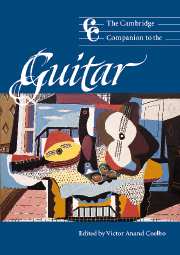Book contents
- Frontmatter
- Part I New guitar histories and world traditions
- Part II Jazz, roots, and rock
- Part III Baroque and classical guitar today
- 10 Radical innovations, social revolution, and the baroque guitar
- 11 Perspectives on the classical guitar in the twentieth century
- 12 Antonio Stradivari and baroque guitar making
- Glossary
- Notes
- Select bibliography
- General index
- Index of song and album titles
11 - Perspectives on the classical guitar in the twentieth century
from Part III - Baroque and classical guitar today
Published online by Cambridge University Press: 28 September 2011
- Frontmatter
- Part I New guitar histories and world traditions
- Part II Jazz, roots, and rock
- Part III Baroque and classical guitar today
- 10 Radical innovations, social revolution, and the baroque guitar
- 11 Perspectives on the classical guitar in the twentieth century
- 12 Antonio Stradivari and baroque guitar making
- Glossary
- Notes
- Select bibliography
- General index
- Index of song and album titles
Summary
At the beginning of the twenty-first century, the classical guitar finds itself at a level of quality and popularity that was unimaginable even fifty years earlier. There are scores of degree programs in the United States alone, major and minor record labels keep increasing their catalog of guitar recordings, and a growing number of international competitions are being won by young players of astounding technical facility. The ubiquitous Rodrigo Concierto de Aranjuez is one of the most popular concertos for any instrument of the twentieth century, new music ensembles commonly include the guitar, and virtually every major composer of our time now attempts to write for the instrument. In fact it can be argued that, for the first time, the current repertoire and performance level of the guitar rival that of any instrument. And such is the embarrassment of riches that many players are seeking out unique corners of the repertoire, becoming specialists in transcription, or nineteenth-century repertoire, or new chamber music. In short, guitarists face the daunting task of finding a voice in this crowded field, which is populated by relatively young players and teachers. But even the youngest players seem to be unfazed, as the number of students entering academic institutions to study the guitar, against all financial reasoning, appears steady.
In this chapter I will connect the major points of the guitar's extraordinary development in the twentieth century, and discuss what are, to me, some of the most promising developments for the future. Since I am foremost a performer, recording artist, and teacher of the guitar – not a musicologist – this essay reveals the thoughts of a player trying to realize his own vision of the instrument. Consequently, this is a personal, rather than an objective view.
- Type
- Chapter
- Information
- The Cambridge Companion to the Guitar , pp. 182 - 206Publisher: Cambridge University PressPrint publication year: 2003
- 1
- Cited by



